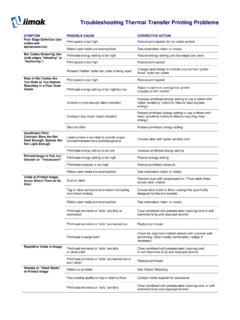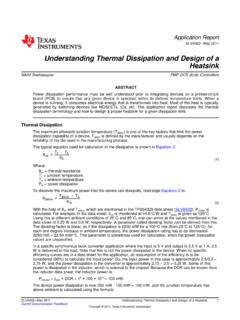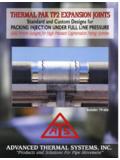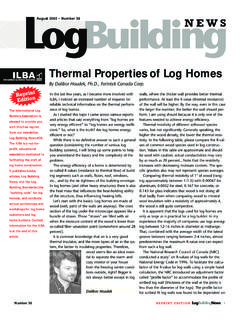Transcription of MT-093: Thermal Design Basics
1 MT-093. TUTORIAL. Thermal Design Basics INTRODUCTION. For reliability reasons, integrated circuits handling appreciable power are increasingly called upon to observe Thermal management. All semiconductors have some specified safe upper limit for junction temperature (TJ), usually on the order of 150 C (sometimes 175 C). Like maximum power supply voltages, maximum junction temperature is a worst case limitation which must not be exceeded. In conservative designs, it won't be approached by less than an ample safety margin. Note that this is critical, since semiconductor lifetime is inversely related to operating junction temperature. Simply put, the cooler ICs are, the more they can approach their maximum life. This limitation of power and temperature is basic, and is illustrated by a typical data sheet statement as in Figure 1.
2 In this case it is for the AD8017AR, an 8-pin SOIC device. The maximum power that can be safely dissipated by the AD8017 is limited by the associated rise in junction temperature. The maximum safe junction temperature for plastic encapsulated device is determined by the glass transition temperature of the plastic, approximately +150 C. Temporarily exceeding this limit may cause a shift in parametric performance due to a change in the stresses exerted on the die by the package. Exceeding a junction temperature of +175 C for an extended period can result in device failure. Figure 1: Maximum Power Dissipation Data Sheet Statement for the AD8017AR, an ADI Thermally Enhanced SOIC Packaged Device Tied to these statements are certain conditions of operation, such as the power dissipated by the device, and the package mounting specifics to the printed circuit board (PCB).
3 In the case of the AD8017AR, the part is rated for W of power at an ambient of 25 C. This assumes operation of the 8-lead SOIC package on a two-layer PCB with about 4 in2 (~2500 mm2) of 2 oz. copper for heat sinking purposes. Predicting safe operation for the device under other conditions is covered below. Thermal Design Basics . The symbol is generally used to denote Thermal resistance. Thermal resistance is in units of C/watt ( C/W). Unless otherwise specified, it defines the resistance heat encounters transferring from a hot IC junction to the ambient air. It might also be expressed more specifically as JA, for Thermal resistance, junction-to-ambient. JC and CA are two additional forms used, and are further explained below. , 01/09, WK Page 1 of 13. MT-093. In general, a device with a Thermal resistance equal to 100 C/W will exhibit a temperature differential of 100 C for a power dissipation of 1 W, as measured between two reference points.
4 Note that this is a linear relationship, so 1 W of dissipation in this part will produce a 100 C. differential (and so on, for other powers). For the AD8017AR example, is about 95 C/W, so W of dissipation produces about a 124 C junction-to-ambient temperature differential. It is of course this rise in temperature that is used to predict the internal temperature, in order to judge the Thermal reliability of a Design . With the ambient at 25 C, this allows an internal junction temperature of about 150 C. In practice most ambient temperatures are above 25 C, so less power can then be handled. For any power dissipation P (in watts), one can calculate the effective temperature differential ( T) in C as: T = P Eq. 1. where is the total applicable Thermal resistance. Figure 2 summarizes a number of basic Thermal relationships.
5 = Thermal Resistance ( C/W). TA AMBIENT. P = Total Device Power Dissipation (W). T = Temperature ( C). CA. T = Temperature Differential = P . JA = Junction-Ambient Thermal Resistance TC CASE. JC = Junction-Case Thermal Resistance CA = Case-Ambient Thermal Resistance JC. JA = JC + CA. TJ = TA + (P JA) TJ JUNCTION. Note: TJ(Max) = 150 C (Sometimes 175 C). Figure 2: Basic Thermal Relationships Note that series Thermal resistances, such as the two shown at the right, model the total Thermal resistance path a device may see. Therefore the total for calculation purposes is the sum, , JA = JC + CA. Given the ambient temperature TA, P, and , then TJ can be calculated. As the relationships signify, to maintain a low TJ, either or the power being dissipated (or both) must be kept low. A low T is the key to extending semiconductor lifetimes, as it leads to lower maximum junction temperatures.
6 Page 2 of 13. MT-093. In ICs, one temperature reference point is always the device junction, taken to mean the hottest spot inside the chip operating within a given package. The other relevant reference point will be either TC, the case of the device, or TA, that of the surrounding air. This then leads in turn to the above mentioned individual Thermal resistances, JC and JA. Taking the most simple case first, JA is the Thermal resistance of a given device measured between its junction and the ambient air. This Thermal resistance is most often used with small, relatively low power ICs such as op amps, which often dissipate 1 W or less. Generally, JA. figures typical of op amps and other small devices are on the order of 90-100 C/W for a plastic 8-pin DIP package, as well as the better SOIC packages.
7 It should be clearly understood that these Thermal resistances are highly package dependent, as different materials have different degrees of Thermal conductivity. As a general guideline, Thermal resistance of conductors is analogous to electrical resistances, that is copper is the best, followed by aluminum, steel, and so on. Thus copper lead frame packages offer the highest performance, , the lowest . HEAT SINKING. By definition, a heat sink is an added low Thermal resistance device attached to an IC to aid heat removal. A heat sink has additional Thermal resistance of its own, CA, rated in C/W. However, most current op amp packages don't easily lend themselves to heat sink attachment (exceptions are older TO-99 metal can types). Devices meant for heat sink attachment will often be noted by a JC dramatically lower than the JA.
8 In this case will be composed of more than one component. Thermal impedances add, making a net calculation relatively simple. For example, to compute a net JA given a relevant JC, the Thermal resistance of the heat sink, CA, or case to ambient is added to the JC as: JA = JC + CA Eq. 2. and the result is the JA for that specific circumstance. More generally however, modern ICs don't use commercially available heat sinks. Instead, when significant power needs to be dissipated, such as 1 W, low Thermal resistance copper PCB. traces are used as the heat sink. In such cases, the most useful form of manufacturer data for this heat sinking are the boundary conditions of a sample PCB layout, and the resulting JA for those conditions. This is in fact the type of specific information supplied for the AD8017AR, as mentioned earlier.
9 Applying this approach, example data illustrating Thermal relationships for such conditions is shown by Figure 3. These data apply for an AD8017AR mounted to a heat sink with an area of about 4 square inches on a 2 layer, 2 ounce copper PCB. These curves indicate the maximum power dissipation vs. temperature characteristic for the AD8017, for maximum junction temperatures of both 150 C and 125 C. Such curves are often referred to as derating curves, since allowable power decreases with ambient temperature. Page 3 of 13. MT-093. Figure 3: Thermal Rating Curves for AD8017AR Op Amp With the AD8017AR, the proprietary ADI Thermal Coastline IC package is used, which allows additional power to be dissipated with no increase in the SO-8 package size. For a TJ(max) of 150 C, the upper curve shows the allowable power in this package, which is W at an ambient of 25 C.
10 If a more conservative TJ(max) of 125 C is used, the lower of the two curves applies. A performance comparison for an 8-pin standard SOIC and the ADI Thermal Coastline version is shown in Figure 4. Note that the Thermal Coastline provides an allowable dissipation at 25 C. of W, whereas a standard package allows only W. In the Thermal Coastline heat transferal is increased, accounting for the package's lower JA. MAXIMUM POWER DISSIPATION (W). 8-PIN Thermal COASTLINE SOIC. 8-PIN STANDARD SOIC. 0. -50 -40 -30 -20 -10 0 10 20 30 40 50 60 70 80 90. AMBIENT TEMPERATURE - ( C). Figure 4: Thermal Rating Curves for Standard (Lower) and ADI Thermal Coastline (Upper) 8-Pin SOIC Packages Page 4 of 13. MT-093. Even higher power dissipation is possible, with the use of IC packages better able to transfer heat from chip to PCB.















